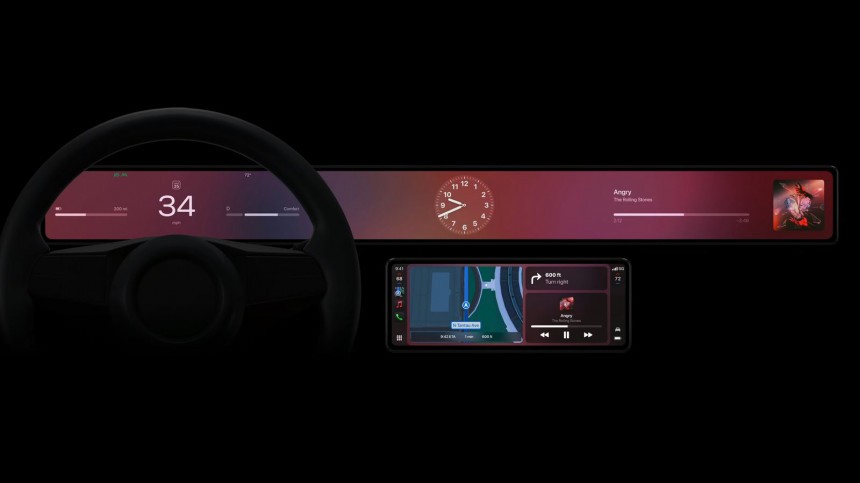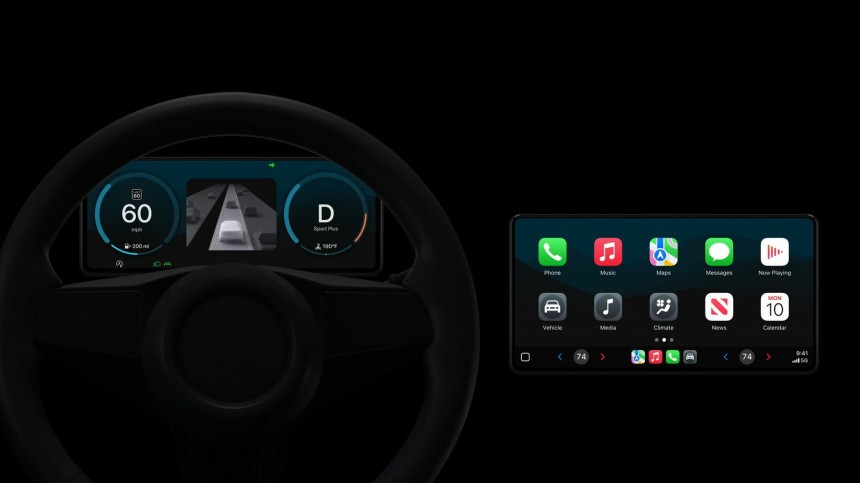The consensus is that Apple isn't committed enough to expanding in the automotive space, and all its efforts barely made any progress in the last couple of years.
CarPlay is living proof.
Apple announced the new-generation CarPlay in 2022 at WWDC, promising to release the first vehicle announcements by the end of 2023. These highly anticipated announcements landed in the last days of 2023 when Porsche and Aston Martin confirmed the adoption of CarPlay 2.0 on MY 2024 models.
Everyone expected Apple to share more information on the new-generation CarPlay, including new carmakers that will adopt the system, at this week's WWDC.
This didn't happen. Apple was all about AI this time, with CarPlay receiving no stage time. Fortunately, the company still shared more information about the updated CarPlay experience, providing us with an early look at how the system can adapt to each screen size, aspect ratio, and configuration in new-generation cars.
The next-generation CarPlay design system highlights how customizable Apple's new experience can be, with the iPhone maker specifically targeting automakers, system developers, and people involved in designing car infotainment experiences.
The company's purpose is to convince carmakers that CarPlay 2.0 is worth investing in, as it allows them to "express your vehicle's character and brand." This is only possible with advanced customization options that can be applied to every component, including gauges, layouts, widgets, and dynamic content running on CarPlay.
The customization freedom is part of Apple's strategy to bring the new CarPlay experience to as many cars as possible.
Instead of enforcing a single design, as it currently happens with the existing CarPlay version, Apple allows carmakers to retain their brand identity with a custom interface compromising different layouts and gauge designs. This means that despite running the same software, two cars from different brands could sport distinct looks. However, Apple retains its design language, so if you're already part of the Apple ecosystem, telling the new CarPlay apart from native vehicle software or other operating systems should be easy.
Google uses the same approach for Android Automotive, where carmakers have the freedom of customizing the look and feel of the operating system. Android Automotive's presence in the car space keeps expanding, whereas Apple is still in the early planning phase, with no model available for purchase with CarPlay 2.0 on board.
The new CarPlay will use all displays on the dashboard, not just the infotainment screen, as is the case with the existing version. It'll also be able to display information on the instrument cluster, and thanks to the customization freedom, carmakers can tweak the gauge design and choose what information they want to display to drivers.
In one example, Apple shows a CarPlay UI that includes the current speed, the driving mode, the mileage, and current trip information. The infotainment screen can display the standard CarPlay interface, including the navigation app, a music streaming service, and essential vehicle controls. A passenger display can be customized for additional data, including a calendar widget with upcoming appointments and weather forecasts for a configured location.
While Apple is committed to providing carmakers with all the resources they need to bring CarPlay to their vehicles, the company still has to resolve one major challenge.
Compared to Android Automotive, which can be used independently from the mobile device and comes pre-loaded with the vehicle hardware, CarPlay 2.0 will require an iPhone to run. This means carmakers will have to invest heavily into adapting the new-generation CarPlay experience instead of their own software without being sure what percentage of their customer base would use it.
Because the experience is limited to Apple users, and Android users will also buy cars, carmakers face a difficult decision.
Eventually, this strategy could lead to low CarPlay 2.0 adoption, especially if carmakers determine that investing in adding support in their vehicles isn't worth the money, work, and time – in this exact order.
Meanwhile, Android Automotive seems to spark more interest in the car space thanks to its capabilities and not being tied to a mobile operating system. While the full Android Automotive feature can be unlocked with an Android smartphone, such as Google Maps data sync, iPhone owners can use the system without major limitations.
Google has already installed Android Automotive on several cars on the road, including models from GM, Honda, and Porsche. The number of carmakers using Android Automotive is expected to grow this year with the addition of Mitsubishi and Infiniti.
Apple has remained tight-lipped on the CarPlay adoption, so the video below is the only closer look we get at the upgraded experience. The company is definitely running out of time, and its questionable strategy could cause major adoption problems in the long term. I expect Apple to discuss CarPlay in detail in September at the iPhone 16 launch event, when the company could also announce that new carmakers are adopting the improved experience.
Apple announced the new-generation CarPlay in 2022 at WWDC, promising to release the first vehicle announcements by the end of 2023. These highly anticipated announcements landed in the last days of 2023 when Porsche and Aston Martin confirmed the adoption of CarPlay 2.0 on MY 2024 models.
Everyone expected Apple to share more information on the new-generation CarPlay, including new carmakers that will adopt the system, at this week's WWDC.
This didn't happen. Apple was all about AI this time, with CarPlay receiving no stage time. Fortunately, the company still shared more information about the updated CarPlay experience, providing us with an early look at how the system can adapt to each screen size, aspect ratio, and configuration in new-generation cars.
The company's purpose is to convince carmakers that CarPlay 2.0 is worth investing in, as it allows them to "express your vehicle's character and brand." This is only possible with advanced customization options that can be applied to every component, including gauges, layouts, widgets, and dynamic content running on CarPlay.
The customization freedom is part of Apple's strategy to bring the new CarPlay experience to as many cars as possible.
Instead of enforcing a single design, as it currently happens with the existing CarPlay version, Apple allows carmakers to retain their brand identity with a custom interface compromising different layouts and gauge designs. This means that despite running the same software, two cars from different brands could sport distinct looks. However, Apple retains its design language, so if you're already part of the Apple ecosystem, telling the new CarPlay apart from native vehicle software or other operating systems should be easy.
The new CarPlay will use all displays on the dashboard, not just the infotainment screen, as is the case with the existing version. It'll also be able to display information on the instrument cluster, and thanks to the customization freedom, carmakers can tweak the gauge design and choose what information they want to display to drivers.
In one example, Apple shows a CarPlay UI that includes the current speed, the driving mode, the mileage, and current trip information. The infotainment screen can display the standard CarPlay interface, including the navigation app, a music streaming service, and essential vehicle controls. A passenger display can be customized for additional data, including a calendar widget with upcoming appointments and weather forecasts for a configured location.
The CarPlay challenge
Compared to Android Automotive, which can be used independently from the mobile device and comes pre-loaded with the vehicle hardware, CarPlay 2.0 will require an iPhone to run. This means carmakers will have to invest heavily into adapting the new-generation CarPlay experience instead of their own software without being sure what percentage of their customer base would use it.
Because the experience is limited to Apple users, and Android users will also buy cars, carmakers face a difficult decision.
Eventually, this strategy could lead to low CarPlay 2.0 adoption, especially if carmakers determine that investing in adding support in their vehicles isn't worth the money, work, and time – in this exact order.
Google has already installed Android Automotive on several cars on the road, including models from GM, Honda, and Porsche. The number of carmakers using Android Automotive is expected to grow this year with the addition of Mitsubishi and Infiniti.
Apple has remained tight-lipped on the CarPlay adoption, so the video below is the only closer look we get at the upgraded experience. The company is definitely running out of time, and its questionable strategy could cause major adoption problems in the long term. I expect Apple to discuss CarPlay in detail in September at the iPhone 16 launch event, when the company could also announce that new carmakers are adopting the improved experience.


















